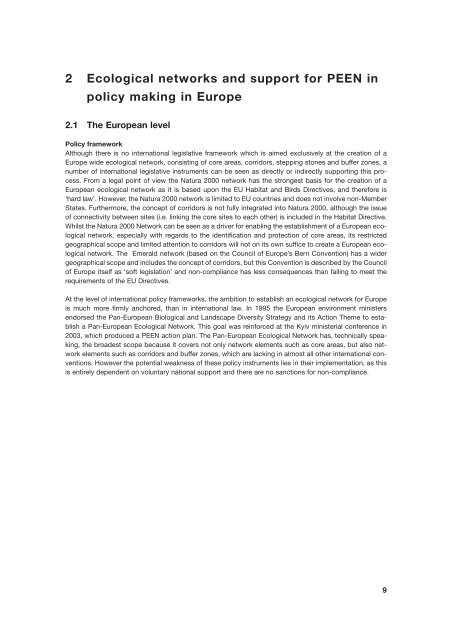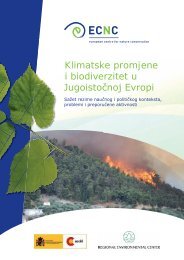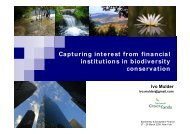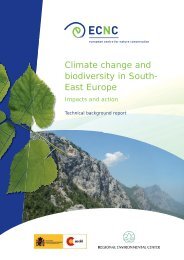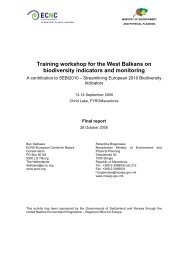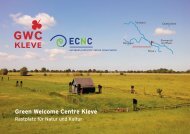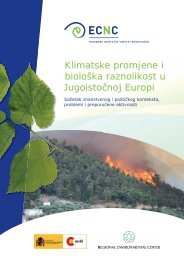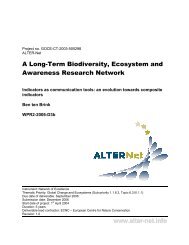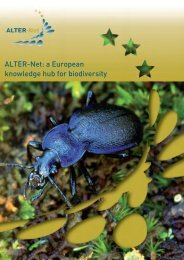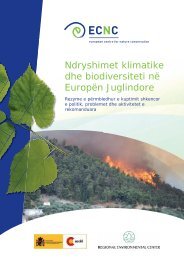2 <strong>Ecological</strong> networks and support for PEEN inpolicy making in Europe2.1 The <strong>European</strong> levelPolicy frameworkAlthough <strong>the</strong>re is no international legislative framework which is aimed exclusively at <strong>the</strong> creation of aEurope wide ecological network, consisting of core areas, corridors, stepping stones and buffer zones, anumber of international legislative instruments can be seen as directly or indirectly supporting this process.From a legal point of view <strong>the</strong> Natura 2000 network has <strong>the</strong> strongest basis for <strong>the</strong> creation of a<strong>European</strong> ecological network as it is based upon <strong>the</strong> EU Habitat and Birds Directives, and <strong>the</strong>refore is‘hard law’. However, <strong>the</strong> Natura 2000 network is limited to EU countries and does not involve non-MemberStates. Fur<strong>the</strong>rmore, <strong>the</strong> concept of corridors is not fully integrated into Natura 2000, although <strong>the</strong> issueof connectivity between sites (i.e. linking <strong>the</strong> core sites to each o<strong>the</strong>r) is included in <strong>the</strong> Habitat Directive.Whilst <strong>the</strong> Natura 2000 <strong>Network</strong> can be seen as a driver for enabling <strong>the</strong> establishment of a <strong>European</strong> ecologicalnetwork, especially with regards to <strong>the</strong> identification and protection of core areas, its restrictedgeographical scope and limited attention to corridors will not on its own suffice to create a <strong>European</strong> ecologicalnetwork. The Emerald network (based on <strong>the</strong> Council of Europe’s Bern Convention) has a widergeographical scope and includes <strong>the</strong> concept of corridors, but this Convention is described by <strong>the</strong> Councilof Europe itself as ‘soft legislation’ and non-compliance has less consequences than failing to meet <strong>the</strong>requirements of <strong>the</strong> EU Directives.At <strong>the</strong> level of international policy frameworks, <strong>the</strong> ambition to establish an ecological network for Europeis much more firmly anchored, than in international law. In 1995 <strong>the</strong> <strong>European</strong> environment ministersendorsed <strong>the</strong> <strong>Pan</strong>-<strong>European</strong> Biological and Landscape Diversity Strategy and its Action Theme to establisha <strong>Pan</strong>-<strong>European</strong> <strong>Ecological</strong> <strong>Network</strong>. This goal was reinforced at <strong>the</strong> Kyiv ministerial conference in2003, which produced a PEEN action plan. The <strong>Pan</strong>-<strong>European</strong> <strong>Ecological</strong> <strong>Network</strong> has, technically speaking,<strong>the</strong> broadest scope because it covers not only network elements such as core areas, but also networkelements such as corridors and buffer zones, which are lacking in almost all o<strong>the</strong>r international conventions.However <strong>the</strong> potential weakness of <strong>the</strong>se policy instruments lies in <strong>the</strong>ir implementation, as thisis entirely dependent on voluntary national support and <strong>the</strong>re are no sanctions for non-compliance.9
PEEN - a Europe wide ecological networkDuring <strong>the</strong> 3rd ‘Environment for Europe’ Ministerial Conference In 1995 up to 54 <strong>European</strong> countriesendorsed <strong>the</strong> action to establish <strong>the</strong> <strong>Pan</strong>-<strong>European</strong> <strong>Ecological</strong> <strong>Network</strong>. It was agreed to establish thisecological network within 20 years.The <strong>Pan</strong>-<strong>European</strong> <strong>Ecological</strong> <strong>Network</strong> (PEEN) aims to ensure that:● a full range of ecosystems, habitats, species and landscapes of <strong>European</strong> importance are conserved;● habitats are large enough to place species in a favourable conservation status;● <strong>the</strong>re are sufficient opportunities for <strong>the</strong> dispersal and migration of species;● damaged parts of <strong>the</strong> key environmental systems are restored;● <strong>the</strong> key environmental systems are buffered from potential threats.The <strong>Pan</strong>-<strong>European</strong> <strong>Ecological</strong> <strong>Network</strong> will be built up of core areas, corridors and buffer zones.Restoration areas will be identified where it is considered necessary.The underlying philosophy of <strong>the</strong> establishment of <strong>the</strong> <strong>Pan</strong>-<strong>European</strong> <strong>Ecological</strong> <strong>Network</strong> is to promotesynergy between <strong>the</strong> existing nature policies, land use planning and rural and urban development. The<strong>Pan</strong>-<strong>European</strong> <strong>Ecological</strong> <strong>Network</strong> offers a framework that will build on and benefit from <strong>the</strong> existingagreements, programmes and initiatives in <strong>the</strong> field of nature conservation.Kyiv Ministerial Conference 2003 Highlights● The ''resolution on biodiversity" was born. The resolution includes <strong>the</strong> requirement for <strong>the</strong> implementation of a PEEN and a statement that all countries agree to <strong>the</strong> PEEN targets.● A target that by 2006, <strong>the</strong> <strong>Pan</strong>-<strong>European</strong> <strong>Ecological</strong> <strong>Network</strong> (core areas, restoration areas, corridorsand buffer zones, as appropriate) in all States of <strong>the</strong> pan <strong>European</strong> region will be identified and reflected on coherent indicative <strong>European</strong> maps, as a <strong>European</strong> contribution towards a global ecologicalnetwork.● A target that by 2008, PEEN guidance will apply to all major national, regional and international landuse and planning policies, as well as to <strong>the</strong> relevant economic and financial sectorsThe EU Water Framework Directive, <strong>the</strong> Convention on Biological Diversity (CBD), <strong>the</strong> Ramsar Convention,<strong>the</strong> World Heritage Convention, <strong>the</strong> Bonn Convention and <strong>the</strong> Helsinki Convention are to a lesser extentalso relevant to <strong>the</strong> implementation of a <strong>European</strong> ecological network. Especially in <strong>the</strong> framework of <strong>the</strong>Convention on Biological Diversity attention for ecological networks is growing, with <strong>the</strong> 7th Conferenceof Parties accepting a work-program for protected areas that specifically also asks <strong>the</strong> parties to take intoaccount issues of connectivity and ecological networks.Challenges and opportunities for a PEENIn <strong>the</strong> course of this study interviews were held with individuals involved in <strong>European</strong> policymaking, <strong>the</strong>seincluded policymakers in DG Environment, but also representatives of <strong>European</strong> level non-conservationstakeholder associations. Researchers involved in <strong>European</strong> research on PEEN were also interviewed. Afirst conclusion can be that <strong>the</strong> policymaking respondents, who were working at <strong>the</strong> <strong>European</strong> policy levelin Brussels, would mainly consider a <strong>European</strong> ecological network in <strong>the</strong> form of networks created in EUMember State countries by conforming to Natura 2000 of <strong>the</strong> EU Habitats Directive. The issue of corridorsbetween sites did not feature strongly in <strong>the</strong>ir understanding, nor did ecological network initiatives developedunder <strong>the</strong> PEBLDS and Kyiv process. This is largely because Natura 2000 and <strong>the</strong> underlying EUDirectives area <strong>the</strong>ir main policy priority when considering ecological networks.Within <strong>the</strong> <strong>European</strong> Commission <strong>the</strong> concept of PEEN is not necessarily taken up as Natura 2000 is seenas its equivalent within <strong>the</strong> EU, and <strong>the</strong> Commission would prefer to continue with Natura 2000 than takeon any o<strong>the</strong>r initiative. Whilst it has been argued that Natura 2000 is not an ecological network due to <strong>the</strong>lack of connectivity, interviewees at <strong>the</strong> Commission consider Natura 2000 ito be better because it focuseson identifiable and specific areas ra<strong>the</strong>r than trying to cover “everything and <strong>the</strong>refore nothing at <strong>the</strong>same time’. Their perception was that <strong>the</strong> method in Natura 2000, by focusing upon <strong>the</strong> designation ofareas, was more pragmatic. It was also thought that concepts such as PEEN and PEBLDS needed to be10
- Page 1 and 2: european centre for nature conserva
- Page 3 and 4: Published by:This publication was m
- Page 5 and 6: Executive SummaryIn 2003, ECNC publ
- Page 7 and 8: ●●The study has highlighted the
- Page 9: NetherlandsEstoniaNorwayUnited King
- Page 13 and 14: Experiences at the EU level, regard
- Page 15 and 16: there may also be huge variations i
- Page 17 and 18: on the effectiveness of implementat
- Page 19 and 20: e the working group involving natio
- Page 21 and 22: Opportunities or challenges for eco
- Page 24 and 25: As mentioned above, there are a lot
- Page 26 and 27: It was felt by some respondents tha
- Page 28 and 29: gained by the work of the NGOs, sci
- Page 30 and 31: nature conservation societies (Prov
- Page 32 and 33: ● Local level support for interna
- Page 34 and 35: istics of the Norwegian landscape,
- Page 36 and 37: policymaking, involving stakeholder
- Page 38 and 39: Some respondents thought a map was
- Page 40 and 41: semi-natural habitats. One responde
- Page 42 and 43: In Scotland, there is a lot of work
- Page 44 and 45: policymakers, researchers, scientis
- Page 46 and 47: Experience and expertise:Over the p
- Page 48 and 49: knowledge also exists regarding the
- Page 50 and 51: At an international level, this is
- Page 52 and 53: lack of integration of policies reg
- Page 54 and 55: ottom-up approach of PEEN requires
- Page 56 and 57: 5 ReferencesSandra Rientjes & Kater
- Page 58 and 59: Methodological Outline●●●●
- Page 60 and 61:
CPA 1 A3Communicating PEENDESK STUD
- Page 62 and 63:
IntroductionThe desk review of the
- Page 64 and 65:
The following two tables, adapted f
- Page 66 and 67:
Habitats DirectiveAssessment of the
- Page 68 and 69:
Ramsar ConventionAssessment of the
- Page 70 and 71:
Assessment ofCommunication,Educatio
- Page 72 and 73:
and other European states, four rep
- Page 74 and 75:
The Act on Sustainable Development
- Page 76 and 77:
In Germany nature conservation by l
- Page 78 and 79:
The management of protected areas f
- Page 80 and 81:
The NvM and the NMP4 are devoted to
- Page 82 and 83:
Assessment of policy and legislatio
- Page 84 and 85:
A Species Action Plan (SAP) has bee
- Page 86 and 87:
CPA 1 A3Communicating PEENExecutive
- Page 88 and 89:
Practical experiences with developi


